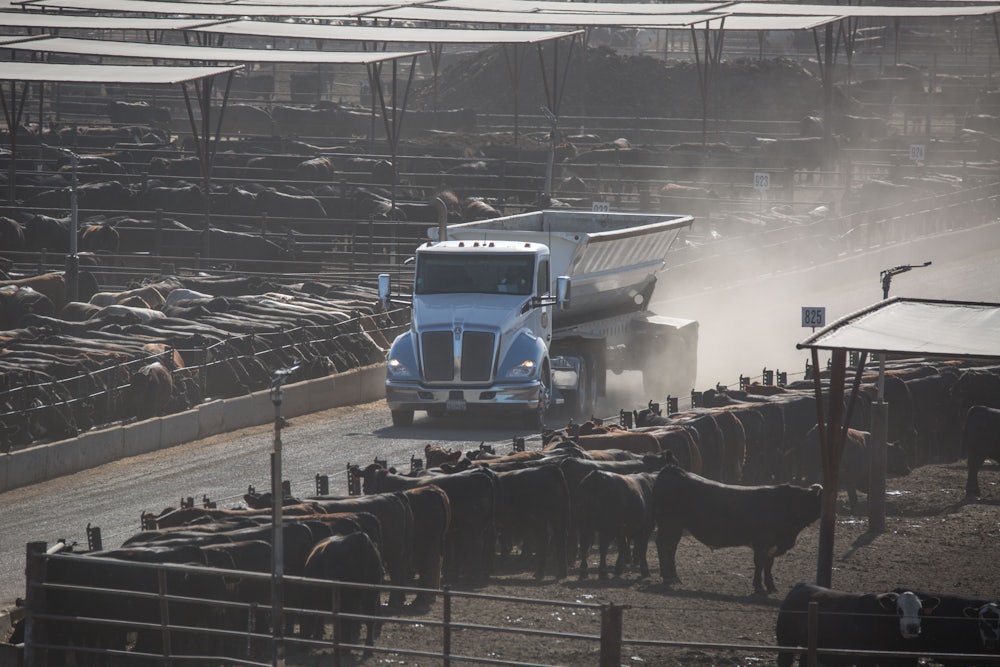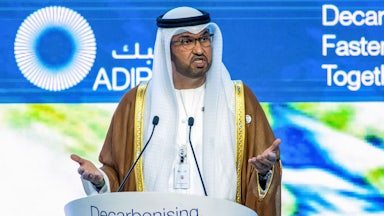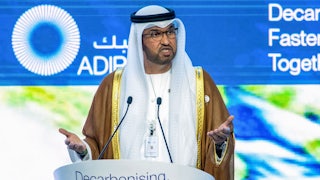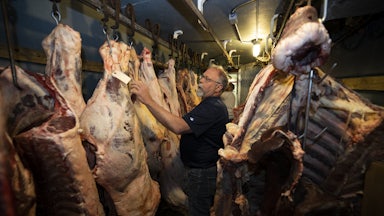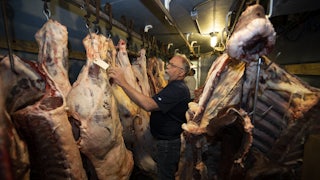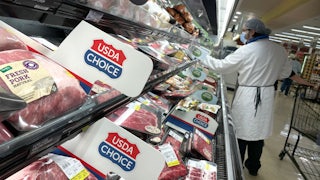Animal agriculture is having its clean coal moment. In 2006, the Food and Agriculture Organization of the United Nations, or FAO, published a report unequivocally linking livestock production to anthropogenic climate change and numerous other forms of ecological destruction. Since then, these findings have been corroborated by extensive further research, which shows that livestock, and primarily methane-belching ruminants like cows, is responsible for about 15 percent of global greenhouse gas emissions.
Given the urgency of the climate crisis, one would think that tackling the single biggest source of food-sector emissions would have been central to serious climate discussions for the past decade and a half. Instead, it has taken that long even to get livestock on the agenda at a major international climate conference like COP28, the U.N. climate talks that concluded on Tuesday in Dubai.
But acknowledging the problem has not translated into a serious discussion of solutions. Rather than reckoning with the need for meat reduction, the FAO’s Global Roadmap for reducing the climate impacts of food systems, released on December 10 to coincide with COP 28’s “Food, Agriculture, and Water Day,” called for increased livestock productivity coupled with emissions reductions via marginal technical mitigations like feed additives and genetic modifications to cattle. Ahead of the talks, the Bezos Earth Fund committed $30 million—over half of its current tranche of climate funding—to funding research into these technologies. Much as the coal industry started hawking “clean coal” in 2008 to avoid policies promoting a phaseout, the meat industry and its defenders are now arguing for clean cows.
The scale of global food production is hard to overstate. Food systems use half of the world’s total habitable land, contribute about a third of all greenhouse gas emissions, and are the biggest culprit in pushing us past planetary boundaries via fresh water use, biodiversity loss, and deforestation. As the latest research from the U.N. Environment Programme shows, meat and dairy make up the biggest part of that by far. Between grazing land and feed production, animal agriculture specifically is responsible for 60 percent of agricultural emissions, 77 percent of agricultural land use, and 50 percent of the world’s harvest of crops. And cattle are the main offender.
We know how to tackle this. Most recent research on keeping global food systems within planetary limits and changing consumption and production to improve human and planetary health stresses the need for a large-scale shift away from animal-based foods, especially in high-income and high-consuming countries like the United States, where the average eater gorges themself on over 220 pounds of meat every year. What this reduction would look like in practice is modeled in the so-called EAT-Lancet diet, a template for balancing nutritional outcomes with sustainability. EAT-Lancet is far from being vegan, but its framework would entail a global reduction in meat consumption of about 50 percent and Americans eating about 80 percent less red meat (in some parts of the world, it would call for a slight increase in meat consumption to meet nutritional needs). Some studies have suggested that a global shift to something like EAT-Lancet could reduce food systems emissions by up to 50 percent.
But meat is a cultural touchstone in rich countries, where consumer freedom might as well be sacrosanct. It is, in short, very difficult to convince people to eat less meat. Plausible policies to reduce meat consumption at the margins can be divided into demand- and supply-side interventions. On the demand side, governments and public health groups can provide consumers with more information about the environmental and climate impact of their foods, be it through dietary guidelines or product labels like the European Union eco-label. Institutions can also change the so-called choice architecture at, for instance, school cafeterias by making plant-based meals the default. On the supply side, production could be restricted by regulations or taxes.
But even getting people to discuss meat’s ecological impact—much less policies to reduce it—has been an uphill battle. The authors of the 2006 FAO report, as well as other livestock methane researchers, were undermined within the FAO at the behest of farming lobby groups. The meat industry has helped fund research and communications initiatives to minimize its links to climate change. And it has organized astroturf attacks on initiatives like EAT-Lancet. Even leading climate communicators have shied away from talking about meat reduction, treating the topic as too personal and too politically touchy.
However, faced with overwhelming evidence of the link between meat and global warming, and growing pressure from academics, civil society, and environmental groups, the meat industry has recently embraced a new approach. Now the strategy seems to be to get ahead of potential regulations and criticism by leaning into methane-reduction technologies like methane biodigesters, which trap methane emitted from factory farm manure lagoons, and methane-inhibiting feed additives meant to be mixed into cows’ feed. These initiatives seem to promise the public that cows can be made low-carbon after all and that we can avoid reducing livestock numbers or the amount of meat in our diets by leaning on technical solutions.
This strategy seems to be working—at least when it comes to convincing policymakers and philanthropists. Technical solutions to livestock’s climate impact have emerged as the new orthodoxy in climate and agriculture circles, repeated by USDA Secretary Tom Vilsack, Biden’s climate envoy John Kerry, the government of Ireland, the new FAO report, and nine-figure philanthropic endeavors funded by groups like the Bezos Earth Fund. It doesn’t hurt that, as the British environmental journalist George Monbiot so aptly puts it, the “livestock industry’s political connections are umbilical.”
It’s a move straight out of the “clean coal” playbook. The dirtiest of fossil fuels and the most ubiquitous, coal should have been phased out decades ago—a relic of our industrializing past. But the coal industry figured out that by selling policymakers and the public on the promise of lower-emissions coal achieved through myriad technical fixes at coal plants, it could indefinitely delay its demise. So-called clean coal, predicated on the capture and sequestering of carbon and the filtering of pollutants during the burning of coal at plants, has won countless billions of dollars in public funding globally and helped stave off the phaseout of the technology. The clean coal myth has now been thoroughly debunked: In the USA, despite widespread government subsidies, some clean coal plants have in fact polluted more, not less, than other plants. Yet the promise of a technological breakthrough always looms just beyond the horizon, earning the industry more money and more time.
The problems with clean cows are similar. Currently, the technologies proposed to reduce their methane might look good in small trials. But they haven’t been implemented or shown to be effective or affordable at any meaningful scale. Scaling the production of methane-inhibiting feed from sources like algae is unproven, and there is little to suggest it can be effectively delivered to the billion-plus cows spread across the globe. Genetic engineering to produce lower-emitting cows and then spreading those breeds globally seems equally quixotic, particularly given the economics and timescale of genetic engineering and patents.
Even if problems of scale and price could be figured out, which is doubtful, their impact would still not be enough to redeem cows as climate saviors. The Bezos Earth Fund claims that the methane-inhibition research it’s funding could reduce livestock emissions “by as much as 30 percent in the next 10-15 years.” Even if this were true, that would still make cows the highest-emission part of the food system, far worse than chicken, pigs, beans, or plant-based meat alternatives. The Irish government, which is looking to slash its agricultural emissions by 25 percent, recently modeled whether it could hit its targets using only methane-inhibiting technologies and found it highly unlikely. And, of course, methane reduction only addresses one of the many planetary limits being trampled by livestock, just as clean coal fails to address the myriad environmental and public health harms of coal.
Promising that existing systems can be greened and that we can avoid uncomfortable discussions about issues like dietary change appeals to the strong status quo bias of the people holding the purse strings in national and global food and climate politics. And, of course, the more the orthodox discourse about livestock emissions reduction embraces technological fixes—much like many climate mitigation models hold out hope of viable carbon capture technology—the more the meat industry can clamor for a seat at the climate table and the funding that comes with it. Much as the U.S. government was convinced to shovel subsidies to the clean coal merchants, it now feeds grants to beef giants like Tyson Foods to support their allegedly lower-emissions beef through its Climate Smart Commodities program. Meanwhile, methane biodigesters have become less a climate-mitigation strategy and more a steady income stream—dubbed “brown gold”—for factory farms. This, in turn, allows the industry to greenwash its products, promising consumers low-carbon, feel-good beef. And that, in turn, plays to consumers’ status quo bias and aversion to change: Beef and dairy might be fine after all!
Painting coal and cows green instead of reducing them is a delay-and-distraction tactic. Yes, there are food-systems reform ideas out there that would massively reduce emissions. And a sustainable future could include a few cows here and there. But the idea that we can gorge ourselves on steaks and still help the climate is bullshit.
